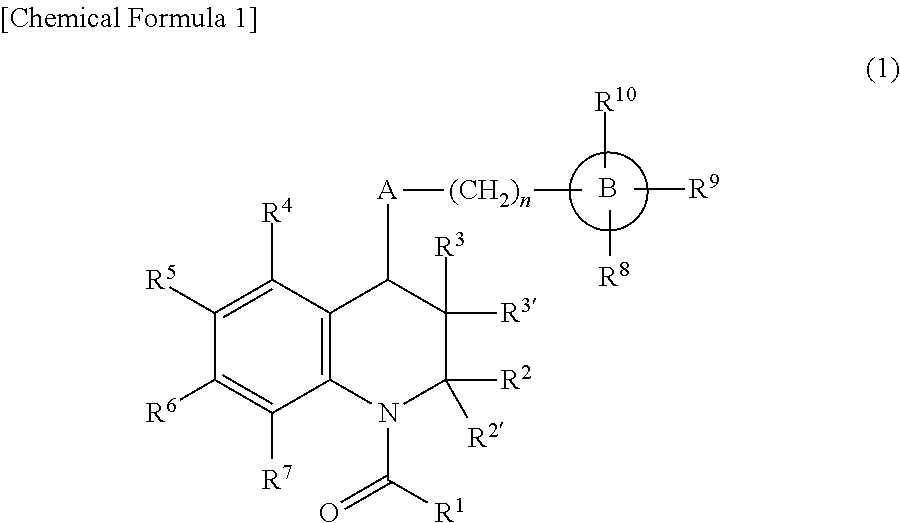Prophylactic and/or therapeutic agent for anemia comprising tetrahydroquinoline compound as active ingredient
a technology of tetrahydroquinoline and anemia, which is applied in the direction of group 3/13 element organic compounds, drug compositions, extracellular fluid disorders, etc., can solve the problems of short plasma half-life, low plasma concentration, and slow release effect of subcutaneous injection
- Summary
- Abstract
- Description
- Claims
- Application Information
AI Technical Summary
Benefits of technology
Problems solved by technology
Method used
Image
Examples
example 1
Production of cis-1-acetyl-8-fluoro-4-[(2-fluorophenyl)amino]-2-methyl-1,2,3,4-tetrahydroquinoline (Compound 4)
[0594][Step 1] 1 g of 2-fluoroaniline, 484 mg of acetaldehyde, and 238 mg of benzotriazole were dissolved in ethanol, and the solution was stirred for 14 hours at room temperature. After completion of the reaction, the reaction product was concentrated under reduced pressure, and the resulting residue was purified by using silica gel chromatography (diethyl ether:hexane=1:5). Thus, 163 mg (13%) of 8-fluoro-4-[(2-fluorophenyl)amino]-2-methyl-1,2,3,4-tetrahydroquinoline was obtained as a yellow oily substance.
[0595][Step 2] 60 mg of cis-8-fluoro-4-[(2-fluorophenyl)amino]-2-methyl-1,2,3,4-tetrahydroquinoline was dissolved in 0.5 mL of pyridine and 2 mL of dichloromethane, and 16 mg of acetyl chloride was added to the solution under ice cooling. The resulting mixture was stirred for 2 hour under ice cooling. After completion of the reaction, water was added to the reaction liqu...
example 2
Production of cis-1-acetyl-4-[(2-fluorophenyl)amino]-2-methyl-1,2,3,4-tetrahydroquinoline (Compound 22)
[0597][Step 1] 50 mg of 1-acetyl-4-oxo-2-methyl-1,2,3,4-tetrahydroquinoline and 83 mg of 2-fluoroaniline were dissolved in 2 mL of toluene, and 125 μL of titanium tetrachloride (1.0 M dichloromethane solution) was added to the solution under ice cooling. The resulting mixture was stirred for one hour under ice cooling, and then was stirred for 3 hours at 80° C. After completion of the reaction, the reaction liquid was filtered through Celite and was concentrated under reduced pressure. The resulting residue was purified by using silica gel chromatography (diethyl ether:hexane=2:1), and thus 60 mg (81%) of 1-acetyl-2-methyl-4-[(2-fluorophenyl)imino]-1,2,3,4-tetrahydroquinoline was obtained as a yellow oily substance.
[0598][Step 2] 60 mg of 1-acetyl-2-methyl-4-[(2-fluorophenyl)imino]-1,2,3,4-tetrahydroquinoline and 28 mg of sodium cyanoborohydride were dissolved in 2 mL of methanol, ...
example 3
Production of cis-1-acetyl-7-bromo-2-methyl-4-phenylamino-1,2,3,4-tetrahydroquinoline (Compound 23)
[0600][Step 1] The production process was carried out in the same manner as in the [Step 2] of Example 1, using 48 my of 7-bromo-4-oxo-2-methyl-1,2,3,4-tetrahydroquinoline, and thus 56 mg (100%) of 1-acetyl-7-bromo-4-oxo-2-methyl-1,2,3,4-tetrahydroquinoline was obtained.
[0601][Step 2] The production process was carried out in the same manner as in Example 2, using 23 mg of 1-acetyl-7-bromo-4-oxo-2-methyl-1,2,3,4-tetrahydroquinoline, and thus 12 mg (60%) of the title compound was obtained as a yellow oily substance.
[0602]1H-NMR (400 MHz, CDCl3) δ: 1.17 (3H, d, J=6.3 Hz), 1.28 (1H, m), 2.22 (3H, s), 2.65 (1H, ddd, J=4.4, 8.4, 12.4 Hz), 3.80 (1H, m), 4.11 (1H, m), 4.86 (1H, m), 6.61 (2H, d, J=8.5 Hz), 6.77 (1H, dd, J=7.3, 7.3 Hz), 7.16-7.2 (5H, m).
PUM
| Property | Measurement | Unit |
|---|---|---|
| time | aaaaa | aaaaa |
| time | aaaaa | aaaaa |
| time period | aaaaa | aaaaa |
Abstract
Description
Claims
Application Information
 Login to View More
Login to View More - R&D
- Intellectual Property
- Life Sciences
- Materials
- Tech Scout
- Unparalleled Data Quality
- Higher Quality Content
- 60% Fewer Hallucinations
Browse by: Latest US Patents, China's latest patents, Technical Efficacy Thesaurus, Application Domain, Technology Topic, Popular Technical Reports.
© 2025 PatSnap. All rights reserved.Legal|Privacy policy|Modern Slavery Act Transparency Statement|Sitemap|About US| Contact US: help@patsnap.com



